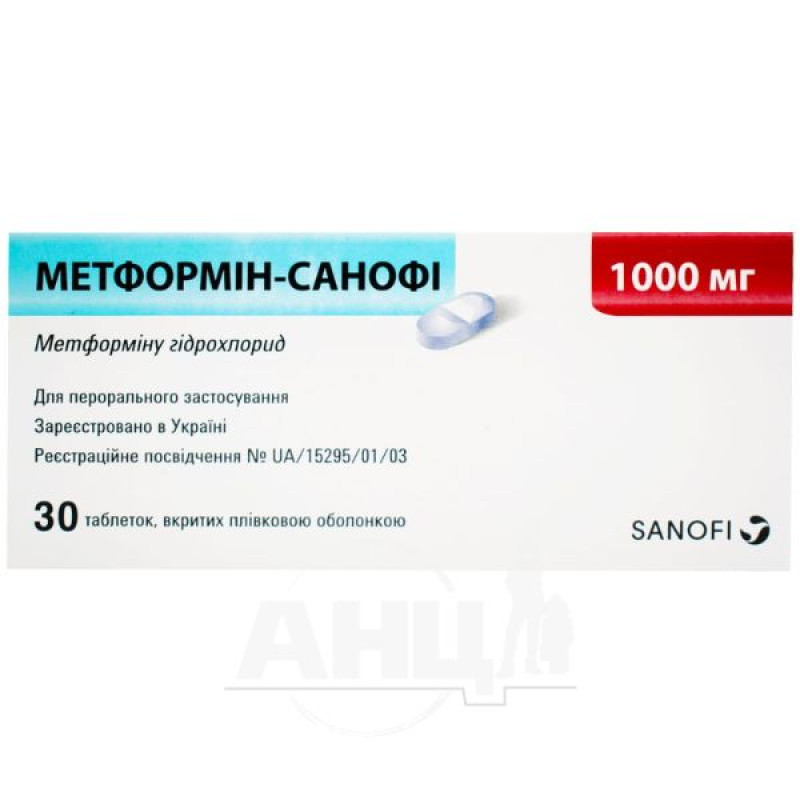Metformin film-coated tablets 1000 mg blister No. 30

Metformin-Sanofi tablets are used for the following indications:
type 2 diabetes mellitus when diet therapy and exercise regimen are ineffective, especially in overweight patients: as monotherapy or combination therapy together with other oral hypoglycemic agents or together with insulin for the treatment of adults; as monotherapy or combination therapy with insulin for the treatment of children aged 10 years and older and adolescents; to reduce complications of diabetes in adult patients with type 2 diabetes mellitus and overweight as a first-line drug when diet therapy is ineffective.Composition
The active substance is metformin hydrochloride (one film-coated tablet contains 1000 mg of metformin hydrochloride).
Excipients: hypromellose, povidone, magnesium stearate, macrogol 6000, titanium dioxide (E 171).
Contraindication
Hypersensitivity to metformin or any component of the drug; any type of acute metabolic acidosis (e.g. lactic acidosis, diabetic ketoacidosis); diabetic coma; severe renal failure (glomerular filtration rate (GFR) <30 ml/minute); acute conditions with a risk of developing renal dysfunction, such as: dehydration, severe infectious diseases, shock; diseases that can lead to the development of tissue hypoxia (especially acute diseases or exacerbation of chronic diseases): decompensated heart failure, respiratory failure, recent myocardial infarction, shock; liver failure, acute alcohol poisoning, alcoholism.Method of application
Adult patients with normal renal function (GFR ≥ 90 mL/minute)
Monotherapy or combination therapy with other oral hypoglycemic agents. Usually the initial dose is 500 mg or 850 mg 2-3 times a day during or after meals. After 10-15 days, the dose should be adjusted according to the results of measurements of serum glucose levels. A slow increase in dose helps to reduce side effects from the digestive tract. When treating with high doses (2000-3000 mg per day), it is recommended to use tablets with a dosage of 1000 mg. The maximum recommended dose is 3000 mg per day, divided into 3 doses. In case of switching from another antidiabetic agent, it is necessary to stop taking this agent and prescribe metformin as indicated above.
Combination therapy with insulin. To achieve better blood glucose control, metformin and insulin can be used as combination therapy. The usual starting dose is 500 mg or 850 mg metformin hydrochloride 2-3 times daily, while the insulin dose should be adjusted according to blood glucose measurements.
Children
Monotherapy or combination therapy with insulin. The drug is used in children aged 10 years and older and adolescents. Usually the initial dose is 500 mg or 850 mg once a day during or after meals. After 10-15 days, the dose should be adjusted according to the results of the measured serum glucose level.
Slowly increasing the dose helps reduce side effects from the digestive tract.
The maximum recommended dose is 2000 mg per day, divided into 2-3 doses.
Application features
Pregnant women
Uncontrolled diabetes during pregnancy (gestational or permanent) increases the risk of congenital anomalies and perinatal mortality. There are limited data from the use of metformin in pregnant women, which do not indicate an increased risk of congenital anomalies. Preclinical studies have not revealed any negative effects on pregnancy, embryonal or fetal development, childbirth and postnatal development. In case of planning pregnancy, as well as in case of pregnancy, it is recommended to use insulin, not metformin, for the treatment of diabetes to maintain blood glucose levels as close to normal as possible, to reduce the risk of fetal malformations.
Metformin is excreted in breast milk, but no adverse effects have been observed in breastfed newborns/infants. However, due to insufficient data on the safety of the drug, breastfeeding is not recommended during metformin therapy. A decision to discontinue breastfeeding should be made taking into account the benefits of breastfeeding and the potential risk of adverse effects to the child.
Metformin did not affect animal fertility when administered at doses of 600 mg/kg/day, which was almost 3 times the maximum recommended daily human dose based on body surface area.
Drivers
Metformin monotherapy does not affect the reaction speed when driving or operating other mechanisms, since the drug does not cause hypoglycemia. However, caution should be exercised when using metformin in combination with other hypoglycemic agents (sulfonylurea derivatives, insulin or meglitinide) due to the risk of hypoglycemia.
Overdose
Side effects
Common adverse reactions at the beginning of treatment are nausea, vomiting, diarrhea, abdominal pain, anorexia. These symptoms in most cases resolve on their own. To prevent the occurrence of these side effects, it is recommended to slowly increase the dosage and use the daily dose in 2-3 doses.
Storage conditions
Store in original packaging and out of reach of children. No special storage conditions required.
Shelf life - 3 years.
There are no reviews for this product.
There are no reviews for this product, be the first to leave your review.
No questions about this product, be the first and ask your question.
